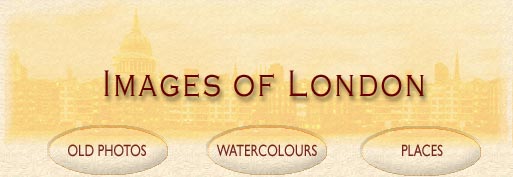
Pictures and history of St.Paul's Cathedral, for many other London attractions and local history pictures select your options from menu:!
 |
St.Paul's Cathedral is among the top London attractions, admired by tourists and Londoners alike. It holds regular church services and also is a museum. Outside Golden Gallery at the top affords remarkable panoramic views of London in good weather.
This pages offers you some interesting facts and information from the history of St. Pauls Cathedral and historic and art pictures of this, what is regarded by many, the greatest English church. To buy a picture click on the image or go to the Images of London online shop.
|
A cathedral is where the Bishop of the Diocese has his 'cathedra' or chair, and St.Paul's is the Cathedral for the Diocese of London. The present building by famous architect Christopher Wren was started after the Great Fire Of London (1666), when the old Gothic-style Cathedral burnt to the ground. It was completed in 1711. |
St.Paul's Cathedral 1872 |
|
St.Pauls 1925 |
St.Paul's is the only cathedral in London built by a single architect (Christopher Wren) and the only cathedral with a dome. Its dome is the second largest in the world, after St.Peter's in the Vatican. For centuries it has been a central place of worship for Londoners and a center of book publishing and trading in the middle ages. Sadly during the Reformation (17th century) St.Paul's came to a decline and was used as a market and later as cavalry barracks by Cromwell. |
|
The imposing building of St.Paul's Cathedral is the fourth to be built on this site. Once there stood a Roman Temple dedicated to Diana. The first cathedral dedicated to St.Paul's was founded here in 604 by St.Ethelbert, King of Kent, the first Christian king in England. Christopher Wren regarded St.Paul's as his most important work and masterpiece. He is buried in the Crypt, where the inscription on his tomb reads (in Latin): 'Reader, if you seek my monument, look around.' |
St.Paul's Front |
|
St.Pauls 1946 |
The only monument to survive the Great Fire of 1666 was the effigy of John Donne, the poet who was Dean of St.Paul's in 1621-31. The Whispering Gallery going around the 365 foot dome is where a message whispered into the wall on one side can clearly be heard 112 feet away on the other side. |
| St.Paul's was damaged during the war, but saved from destruction by a special corps of volunteer fire-watches. |
St.Paul's from Paternoster Rd after bombing |
|
View from St.Bride's |
It has been the setting for many great state occasions, including the funerals of Admiral Nelson (1806), the Duke of Wellington (1852) (both have tombs here) and Sir Winston Churchil (1965), and the wedding of Prince Charles and Diana in 1981. |
|
For centuries St.Paul's Cross was the place of announcements of victories, royal marriages, excommunications and other state occasions. A historian called it the 'Times newspaper of the Middle Ages'. St.Paul's Cross was a wooden, lead-covered pulpit. Despite being struck by lightning in 1382, it survived until the Civil War when it was destroyed in 1643 by order of Parliament. |
|
|
Ludgate Hill 1916 |
The statue in front of St.Paul's is commemorating Queen Anne, in whose reign it was completed. As it looks away from the Cathedral, a contemporary satirist, wrote, referring to her indulgence: 'Brandy Nan, Bra |